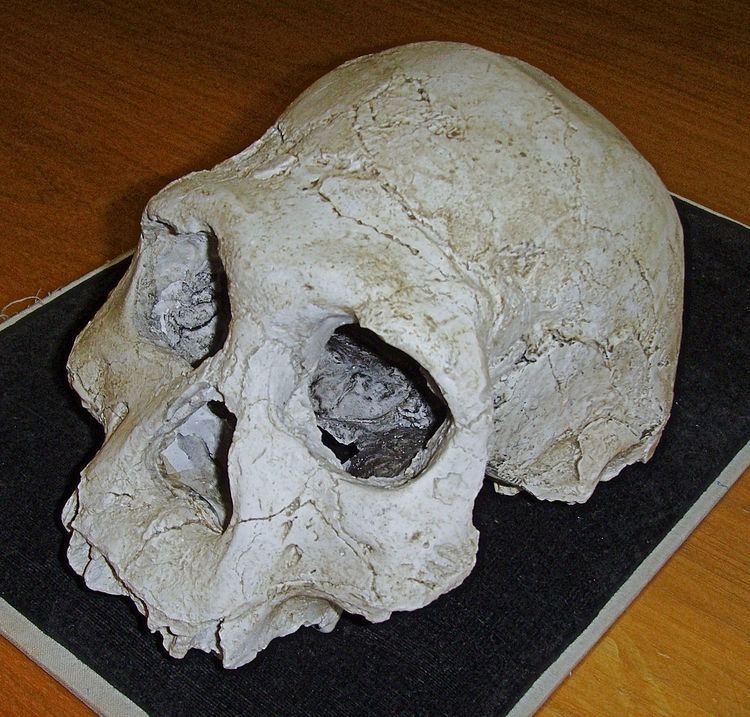Catalog no. D2700 Species Homo georgicus | Common name Dmanisi skull 3 Age 1.8 million years Date discovered 2001 | |
 | ||
D2700, also known as Skull 3, is the catalogue number of a fossilized Homo georgicus skull which was discovered in 2001 in Dmanisi, Georgia. It is an almost complete skull and is in an exceptionally good condition.
Contents
Since the publication of the Dmanisi skull 5 in 2013, all of the five Dmanisi skulls (Skull 3 included) are involved in a paleontological controversy: many hominin fossils thought to be of different species, such as Homo ergaster or Homo habilis, may not be separate species after all. Most human ancestors were possibly one evolving lineage.
Discovery
D2700 and D2735 were found in 2001, just a decade after the first discovery of an early hominin mandible D211 at Dmanisi on September 24, 1991. In 1999, partial crania D2280 and D2282 were discovered. Cranium D2282 is likely the accompanying skull to mandible D211 and to be the remains of a young adult around 18–20 years old. Skull D2280 is inferred to have been an adult around 25–30 years old at the time of death. Moreover, in 2005, a new complete skull cranium was found: D4500. This cranium is inferred to be an adult skull and is more commonly known as “Skull 5.” D4500’s features are very rare compared to early Homo in that it had a small braincase yet an unusually large prognathic face. “Skull 5” has an accompanying mandible, D2600, which was found in 2000.
In 1999 two other skulls had been found at the same site—D2280 and D2282. D2280 was a near-complete brain-case with 780 cc brain-size. D2282 was a cranium and it included many of the facial and upper jaw bones. Its brain size was about 650 cc. In 1991 and 2000, two more lower jaws D211 and D2600 were discovered from the same site.
Observations
The skull was found in an exceptionally good condition including a lower jaw (D2735) found about a meter away which is considered to be of the same person. D2700 is smaller than D2282. The fossil is about 1.8 million years old and its brain size is estimated at 600 cc. There are many characteristics in which it resembles H. ergaster (or H. erectus) and also a number that resembles the ER1813. Vekua et al., concluded in their 2002 paper:
In overall shape, D2700 is similar to D2280 and D2282, and D2735 resembles D211. Despite certain differences among these Dmanisi individuals, we do not see sufficient grounds for assigning them to more than one hominid [now, "hominin"] taxon. We view the new specimen as a member of the same population as the other fossils, and we here assign the new skull provisionally to Homo erectus.
All Dmanisi hominin remains were suggested to have been buried quickly after death. D2700 was found with four upper teeth, while D2735 contained eight teeth. As both fossil hominin remains are jointed, it is found that they ultimately fit one another. D2700’s narrow nasal bones were found inferiorly broken from the orbital margins. Because the cranium’s upper molars were partially erupted, D2700 is believed to have been the skull of a 13 to 15-year-old individual. It is considered that the skull was of a teenager.
Species controversy
It was conjectured that the categorical differences seen in for instance the mandibular and dental features of the crania from Dmanisi, may be ascribed to taxonomic diversity, as opposed to all five deriving from the same H. erectus lineage. The rather small braincase of D2700 was believed to be at odds with the characteristics of H. erectus. H. georgicus was besides small in size compared to H. erectus. For these reasons, D2700, along with the other Dmanisi fossil remains, was ascribed to the new species H. georgicus.
Gender controversy
The smaller size of the D2700 skull compared to skulls D2280 and D2282 suggests sexual dimorphism, and consequently that D2700 may be the skull of a female. The more slender features of this cranium compared to its more robust featured counterparts are theorized to support this possibility. There is uncertainty of deciding gender, however, considering the huge upper canines and large crowns found.
The 5 Dmanisi skulls are:
